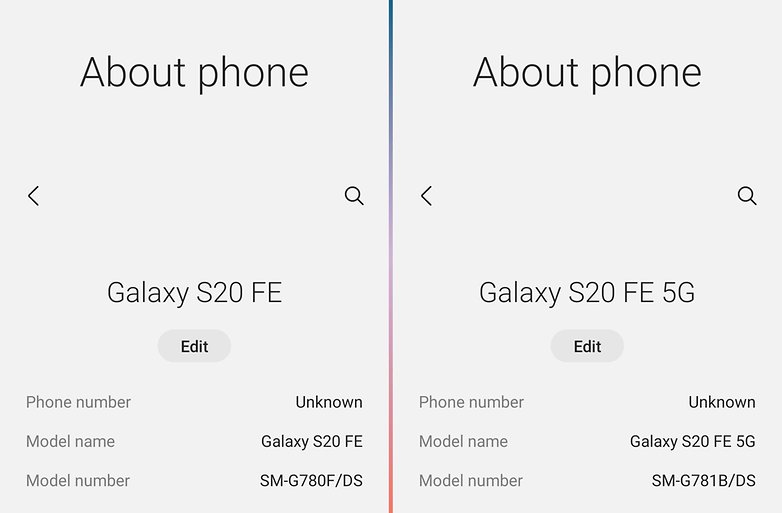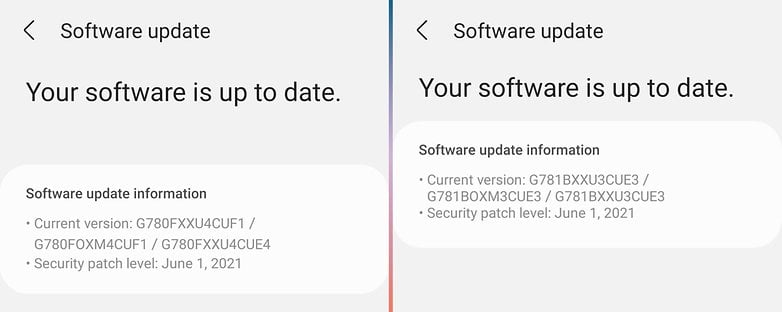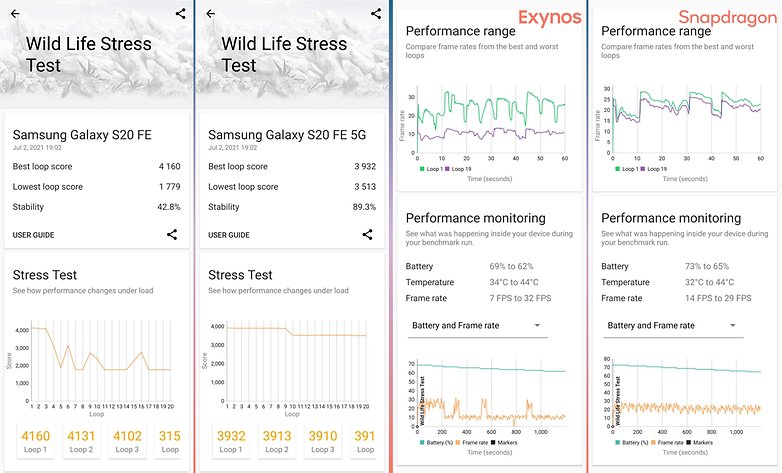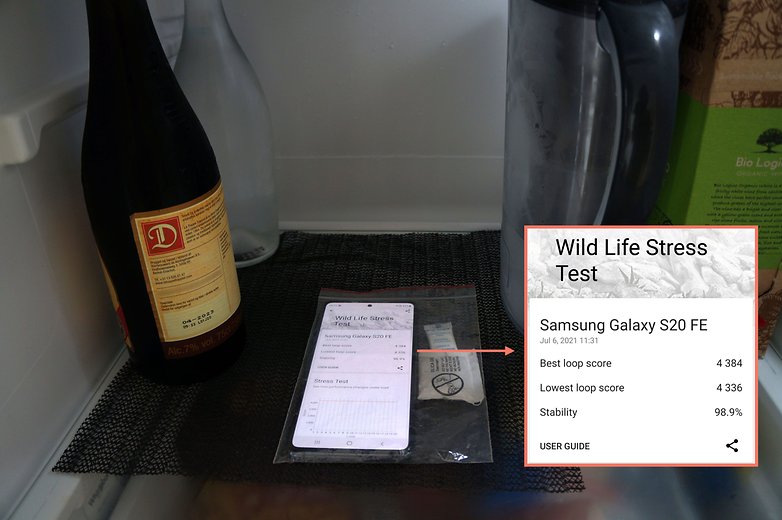Samsung Galaxy S20 FE: Exynos vs Snapdragon?
This article is not a traditional comparison like those normally found here on NextPit. Both models are virtually identical in terms of specifications and components, except for the SoC used.
Exynos and Snapdragon on the same shelf
The Galaxy S20 FE was launched in late 2020 with two versions — a 4G version equipped with the Samsung Exynos 990 processor and a 5G version with the Qualcomm Snapdragon 865 — and this was region-independent. After all, Samsung Electronics traditionally reserves its Snapdragon-powered phones for the Chinese and North American markets.
Recently, the version with the Exynos 990 gave way in Europe and Brazil to a new revision equipped with the Snapdragon 865. The new model, still 4G, can be identified by the product code SM-G780G — against the identifiers SM-G780F and SM-G781B of the original 4G and 5G versions, respectively.
We weren't able to get hold of the new revision to compare it to the old one, but we've put the 4G and 5G versions head-to-head anyway. It's worth noting that in addition to the processor, the 5G model includes a Snapdragon X55 modem — the same one used in the iPhone 12 line — but all tests were done without a SIM card to try to isolate the impact of the component as much as possible.

Galaxy S20 FE 4G (left) gained a new version in 2021, SM-G780G, equipped with Snapdragon 865 / © NextPit
Bug fixed and performance improvement
For illustration purposes, before performing the benchmarks with the most current version of the firmware, we ran the tests on the version sent by Samsung from the factory, to try to identify variations in the behavior of the two Galaxy S20 FE.
In the case of the 5G model with Snapdragon, even with the transition between OneUI 2.5 with the October 2020 patch and the updated OneUI 3.1 system, there was no significant variation in the results. On the other hand, the Exynos model (shipped with the December 2020 firmware, with OneUI 3.0) showed a significant performance improvement, in addition to the correction of a bug.
In the first run of the 3DMark Wild Life benchmark, the device consistently recorded a lower score — around 2,190 points — followed by subsequent scores in the 4,200s. In the case of the Stress Test, the initial score was between 2,115 and 2,136 points and then between 1,750 and 4,200 points.
After updating the devices to the latest firmware, from June 2021, and resetting the factory settings, the 4G model began to behave more consistently, in addition to improving performance in some benchmarks.

Updated devices. Layout has a curious difference between models / © NextPit
Performance: Exynos 990 vs Snapdragon 865
| Benchmark | Snapdragon 865 | Exynos 990 |
|---|---|---|
| 3DMark Wild Life | 3,927 | 4,170 (3,599) |
| 3DMark Wild Life Stress Test | 3,513 ~ 3,932 | 1,779 ~ 4,160 (2,115~2,136) |
| Geekbench single-core | 901 | 887 (785) |
| Geekbench multi-core | 3.222 | 2,594 (2,399) |
| PassMark RAM | 25,907 | 24,024 (22,788) |
| PassMark storage | 60.208 | 58,174 (59,310) |
| GFXBench Aztec (Normal, offscreen) | 3,797 | 3.184 |
| () = score with original firmware | ||
In terms of temperature, both models heated up normally, but the Exynos version was clearly more susceptible to thermal bottleneck (thermal throttling), lowering performance over time in longer benchmarks to avoid overheating.
In practice, this has the potential to manifest itself in performance variations in games, with frame rates dropping over longer gaming sessions. The Wild Life Stress Test benchmark illustrates this well (test performed without a SIM card, with airplane mode enabled):

Exynos 990 (left) starts with superior graphics performance, but soon falls behind to avoid overheating / © NextPit
The 5G model achieved much more consistent results, with a stability rate of 89.3% — compared to 42.8% for the Exynos version.
Thermal throttling in practice
To prove the thermal throttlingwe resort to an unrealistic test — unless you live in the midnight sun region — with the Galaxy S20 FE 4G running the same test in the refrigerator. Don't try this at home, please.

I repeat, do not try this at home! / © NextPit
The result was not only a more stable score — ranging from 4,336 to 4,384 points, a stability of 98.9% — but also superior to the model at room temperature, which varied between 20 and 24 degrees during regular testing.
Of course, the test is not relevant for everyday use, but it shows that the Exynos 990 struggles to offer performance equivalent to the Snapdragon 865, but that it cannot sustain it in the medium term. The observation may not apply to traditional smartphone use, with short periods of intense use, but it is something to keep in mind during gaming sessions, recording and editing high-definition videos and other more demanding tasks.
Which processor consumes more battery
In addition to the performance difference, another common comment made about Exynos processors is that they consume more energy and, consequently, have a shorter battery life. To test the processors, we used the PCMark application's consumption test, which simulates common tasks when using a cell phone until it reaches 20% charge.
Here, even with a modem installed next to the SoC (which remained disabled during the test), the Galaxy S20 FE with the Snapdragon 865 showed greater battery life, with 12h12min in the test, compared to 9h32min for the model equipped with the Exynos 990 SoC.

With the same task load, the Exynos smartphone had lower battery life / © NextPit
PCMark Work 3.0
| Scores | Exynos 990 | Snapdragon 865 |
|---|---|---|
| Battery life | 9:32 am | 12:12 p.m. |
| Overall performance | 12,753 | 12,863 |
| Web navigation | 10,857 | 10,914 |
| Video editing | 6,896 | 7.137 |
| Text editing | 12,531 | 14,035 |
| Image editing | 33,799 | 29.309 |
| Data processing | 10,636 | 10,991 |
In the processing tests performed by PCMark, the two SoCs presented similar results overall, reinforcing the perception of equivalent performance for daily tasks, but in this case, at the cost of battery consumption.
Conclusion: Exynos or Snapdragon?
This comparison focused on the performance differences between the Exynos 990 and Snapdragon 865-powered versions of the Galaxy S20 FE. Ideally, we would have used the new 4G model with the Snapdragon 865 (SM-G780G), but that wasn't possible for this article.
Apart from the processor and modem, the devices are basically identical, including in the main daily tasks. In some situations, however, the loading time of the tests was slightly longer in the Exynos model, reflecting the difference in the PassMark app's storage test score.
What is noticeable when testing the devices side by side is the higher power consumption of the Galaxy S20 FE with the Exynos 990 processor, in addition to the greater variability of results for longer and more demanding tests, in which temperature control reduces the speed of the CPU cores to prevent overheating – a trend in the flagship Exynos 2100 and Snapdragon 888 processors of the 2021 season, both manufactured by Samsung Foundry.
If you are considering purchasing the Galaxy S20 FE 4G, it is worth keeping an eye on the model identifier, and preferring the SM-G780G model equipped with the Snapdragon 865, mainly due to its greater autonomy of use.
Although the strategy of different processors for different regions of the world shows no sign of changing, at least the performance difference between the 2021 SoCs is much less noticeable, as this year's reviews show.
Speaking of analytics, stay tuned to NextPit to read the full Samsung Galaxy S20 FE 5G review. If you’re interested in seeing how the Snapdragon 865 performs in the fridge test, be sure to leave a comment!
Samsung Galaxy S20 FE 4G vs Galaxy S20 FE 5G
| Samsung Galaxy S20 FE 4G SM-G780F | Samsung Galaxy S20 FE 5G SM-G781B | |
|---|---|---|
| Processor | Samsung Exynos 990
| Qualcomm Snapdragon 865
|
| Memory | 8/128 GB (on tested models) | |
| Operating system | Android 11, with OneUI 3.1 (RP1A.200720.012.G780FXXU4CUF1) | Android 11, with OneUI 3.1 (RP1A.200720.012.G781BXXU3CUE3) |
| Security patch | June 1, 2021 | |
Check out other articles about the Samsung Galaxy S family at NextPit:
